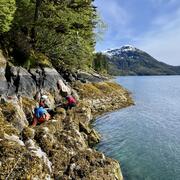Fish
Fish
Filter Total Items: 14
Hydro-Ecology of Arctic Thawing (HEAT): Ecology
Permafrost thaw is leading to a myriad of changes in physical and chemical conditions throughout the Arctic.
Nearshore Fish Surveys in the Beaufort Sea
Nearshore systems provide habitat to a unique community of marine and diadromous (lives in both fresh and saltwater) fish and support high fish abundance.
Fish and Aquatic Ecology
Fish and aquatic habitats in Alaska support important commercial, sport, and subsistence fisheries and provide forage fish that support wildlife populations. The USGS Alaska Science Center conducts interdisciplinary research to inform local, state, federal, and international policy makers regarding conservation of fish, aquatic species, and their habitats. We work collaboratively with hydrologists...
ASC Ecosystems Data Releases
Alaska Science Center Ecosystems data releases are grouped by topic: Terrestrial Ecosystems, Aquatic Ecosystems, Wildlife Health and Genetics, Environmental Health and eDNA, Habitat and Landscape Change, and Ecosystem Analytics.
Q&A: USGS Ecosystems Provides Objective Science to Manage Lands, Fish, and Wildlife
The USGS Ecosystems Mission Area is the only program within the Department of Interior (DOI) focused on generating science to inform the management of the nation’s lands, fish, and wildlife. The Ecosystems Mission Area is also the only entity with the specific role of meeting the information needs of DOI agencies (e.g., Bureau of Land Management, Bureau of Ocean Energy Management, National Park...
Detecting Long-term Changes in Forage Fish Populations in Prince William Sound, Alaska
Forage fish are small pelagic schooling fish that play a key role in transferring energy between plankton and top marine predators. Many seabirds, marine mammals, and commercial fish species depend on forage fish to grow and survive.
Assessing heat stress in migrating Yukon River Chinook Salmon
We will examine evidence of heat stress in Yukon River Chinook salmon ( Oncorhynchus tshawytscha) using heat shock proteins and gene expression.
Tidewater Glacier Influence on Marine Ecosystems
Where glaciers meet the sea in the Gulf of Alaska (GOA), they create unique and productive marine habitats. Ringed by the continent’s tallest coastal mountains, 20% of the GOA coastal watershed is covered by glacial ice and the annual freshwater discharge into the GOA from glacial melt is comparable to that of the Mississippi river.
Condition of Forage Fish in Prince William Sound During the Marine Heatwave
Changes in the body condition of a key forage fish species, Pacific sand lance ( Ammodytes personatus), are examined to understand how energy transfer to predators may have been disrupted during the recent marine heatwave in the North Pacific (late 2013 to mid 2016).
Winter Habitat of Juvenile Dolly Varden in the Canning River
In the Arctic, rivers often freeze all the way to the bottom each winter leaving fish with limited habitat where they can survive.
Ecosystem Shifts in Arctic Seas
In addition to the direct effects of sea ice loss on walrus ( Odobenus rosmarus divergens) and polar bears ( Ursus maritimus) that use ice as a platform, the decline of Arctic sea ice is predicted to promote a fundamental ecosystem shift from benthic animals that forage on the sea floor to pelagic animals that forage near the sea surface.
Lake Trout Biochronologies as Long-term Climate and Productivity Indicators in Alaska Lake Ecosystems
High latitude ecosystems are among the most vulnerable to long-term climate change, yet continuous, multidecadal indicators by which to gauge effects on biology are scarce, especially in freshwater environments.













